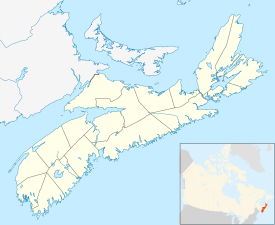
A | B | C | D | E | F | G | H | CH | I | J | K | L | M | N | O | P | Q | R | S | T | U | V | W | X | Y | Z | 0 | 1 | 2 | 3 | 4 | 5 | 6 | 7 | 8 | 9
Halifax
Kji'puktuk (Mi'kmaq) | |
|---|---|
 Downtown Halifax in July 2007 | |
 Map of the boundaries of the former Halifax and the relationship to the rest of the regional municipality | |
Location of Halifax in Nova Scotia | |
| Coordinates: 44°40′12″N 63°36′36″W / 44.67000°N 63.61000°W | |
| Country | |
| Province | |
| Municipality | Halifax |
| Founded | 21 June 1749 |
| City | 1842 |
| Amalgamated | 1 April 1996 |
| Area | |
| • Land | 61.961 km2 (23.923 sq mi) |
| Elevation | 0–119 m (0−390 ft) |
| Population (2021) | |
| • Total | 156,141 |
| • Density | 2,519/km2 (6,520/sq mi) |
| Time zone | UTC-4 (AST) |
| • Summer (DST) | UTC-3 (ADT) |
| Canadian Postal code | B3H to B3S |
| Area code(s) | 782, 902 |
| GNBC Code | CAPHL |
| NTS Map | 011D12 |
The community of Halifax, Nova Scotia was created on 1 April 1996, when the City of Dartmouth, the City of Halifax, the Town of Bedford, and the County of Halifax amalgamated and formed the Halifax Regional Municipality. The former City of Halifax was dissolved, and transformed into the Community of Halifax within the municipality.
As of 2021, the community has 156,141 inhabitants within an area of 61.961 km2 (23.923 sq mi).
History
| History of Halifax, Nova Scotia |
|---|
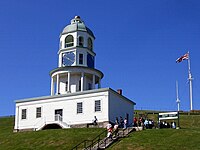 |
18th century


The Halifax area has been territory of the Miꞌkmaq since time immemorial. Before contact they called the area around the Halifax Harbour Jipugtug (anglicised as "Chebucto"), meaning Great Harbour.[1][2] Prior to the establishment of Halifax, the most remarkable event in the region was the fate of the Duc d'Anville Expedition, which led to significant disease and death among the local Miꞌkmaq people. There is evidence that bands would spend the summer on the shores of the Bedford Basin, moving to points inland before the harsh Atlantic winter set in. Examples of Miꞌkmaq habitation and burial sites have been found from Point Pleasant Park to the north and south mainland.
The community was originally inhabited by the Miꞌkmaq. The first European settlers to arrive in the future Halifax region were French, in the early 1600s, establishing the colony of Acadia. The British settled Halifax in 1749, which sparked Father Le Loutre's War.[3] To guard against Miꞌkmaw, Acadian, and French attacks on the new Protestant settlements, British fortifications were erected in Halifax (Citadel Hill) (1749), Bedford (Fort Sackville) (1749), Dartmouth (1750), and Lawrencetown (1754). St. Margaret's Bay was first settled by French-speaking Foreign Protestants at French Village, Nova Scotia, who migrated from Lunenburg, Nova Scotia, during the American Revolution. All of these regions were amalgamated into the Halifax Regional Municipality (HRM) in 1996. While all of the regions of HRM developed separately over the last 250 years, their histories have also been intertwined.
Despite the Conquest of Acadia in 1710, no serious attempts were made by Great Britain to colonize Nova Scotia, aside from its presence at Annapolis Royal and Canso. The peninsula was dominated by Catholic Acadians and Miꞌkmaw residents. The British founded Halifax in order to counter the influence of the Fortress of Louisbourg[4] after returning the fortress to French control as part of the Treaty of Aix-la-Chapelle (1748).[5]
The Town of Halifax was founded by the Kingdom of Great Britain under the direction of the Board of Trade under the command of Governor Edward Cornwallis in 1749.[6] The British founding of Halifax and the influx of British Protestant settlers led to Father Le Loutre's War.[3] During the war, Miꞌkmaq and Acadians raided the capital region 13 times.
The first European settlement in the community was an Acadian community at present-day Lawrencetown. These Acadians joined the Acadian Exodus when the British established themselves on Halifax Peninsula. The establishment of the Town of Halifax, named after the British Earl of Halifax, in 1749 led to the colonial capital being transferred from Annapolis Royal.
Father Le Loutre's War


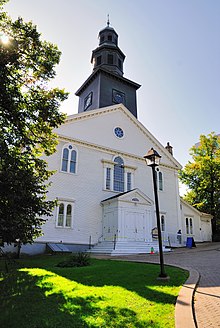
The establishment of Halifax marked the beginning of Father Le Loutre's War. The war began when Edward Cornwallis arrived to establish Halifax with thirteen transports and a sloop-of-war on June 21, 1749.[7] By unilaterally establishing Halifax the British were violating earlier treaties with the Miꞌkmaq (1726), which were signed after Father Rale's War.[8] Cornwallis brought along 1,176 settlers and their families. In 1750, the sailing ship Alderney arrived with 151 immigrants. Municipal officials at Halifax decided that these new arrivals should be settled on the eastern side of Halifax Harbour.
During Father Le Loutre's War, the Miꞌkmaq and Acadians raided in the capital region (Halifax and Dartmouth) twelve times. On September 30, 1749, about forty Miꞌkmaq attacked six men who were in Dartmouth cutting trees. Four of them were killed on the spot, one was taken prisoner and one escaped.[9] Two of the men were scalped and the heads of the others were cut off. The attack was on the sawmill which was under the command of Major Gilman. Six of his men had been sent to cut wood. Four were killed and one was carried off. The other escaped and gave the alarm. A detachment of rangers was sent after the raiding party and cut off the heads of two Miꞌkmaq and scalped one.[10] This raid was the first of eight against Dartmouth.
The result of the raid, on October 2, 1749, Cornwallis offered a bounty on the head of every Miꞌkmaq. He set the amount at the same rate that the Miꞌkmaq received from the French for British scalps. As well, to carry out this task, two companies of rangers raised, one led by Captain Francis Bartelo and the other by Captain William Clapham. These two companies served alongside that of John Gorham's company. The three companies scoured the land around Halifax looking for Miꞌkmaq.[11]
In July 1750, the Miꞌkmaq killed and scalped seven men who were at work in Dartmouth.[12] Four raids were against Halifax Peninsula. The first of these was in July 1750: in the woods on peninsular Halifax, the Miꞌkmaq scalped Cornwallis' gardener, his son, and four others. They buried the son, left the gardener's body exposed, and carried off the other four bodies.[12]
In August 1750, 353 people arrived on Alderney and began the town of Dartmouth. The town was laid out in the autumn of that year.[13] The following month, on September 30, 1750, Dartmouth was attacked again by the Miꞌkmaq and five more residents were killed.[14]
In October 1750 a group of about eight men went out "to take their diversion; and as they were fowling, they were attacked by the Indians, who took the whole prisoners; scalped ... with a large knife, which they wear for that purpose, and threw him into the sea ..."[15] The next year, on March 26, 1751, the Miꞌkmaq attacked again, killing fifteen settlers and wounding seven, three of which would later die of their wounds. They took six captives, and the regulars who pursued the Miꞌkmaq fell into an ambush in which they lost a sergeant killed.[16] Two days later, on March 28, 1751, Miꞌkmaq abducted another three settlers.[16]
Dartmouth Massacre


The worst of these raids was the Dartmouth Massacre (1751). Three months after the previous raid, on May 13, 1751, Broussard led sixty Miꞌkmaq and Acadians to attack Dartmouth again, in what would be known as the "Dartmouth Massacre".[17] Broussard and the others killed twenty settlers - mutilating men, women, children and babies, and took more prisoners.[18] A sergeant was also killed and his body mutilated. They destroyed the buildings. The British returned to Halifax with the scalp of one Miꞌkmaw warrior, however, they reported that they killed six Miꞌkmaw warriors.[19]
In 1751, there were two attacks on blockhouses surrounding Halifax. Miꞌkmaq attacked the North Blockhouse (located at the north end of Joseph Howe Drive) and killed the men on guard. They also attacked near the South Blockhouse (located at the south end of Joseph Howe Drive), at a sawmill on a stream flowing out of Chocolate Lake. They killed two men.[20] (Map of Halifax Blockhouses | Map 2)
In 1753, when Lawrence became governor, the Miꞌkmaq attacked again upon the sawmills near the South Blockhouse on the Northwest Arm, where they killed three British. The Miꞌkmaq made three attempts to retrieve the bodies for their scalps.[21]
Prominent Halifax business person Michael Francklin was captured by a Miꞌkmaw raiding party in 1754 and held captive for three months.[22]
French and Indian War



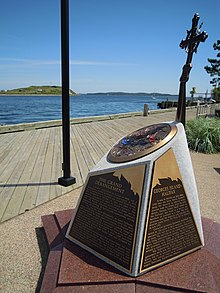

The town proved its worth as a military base in the French and Indian War (the North American Theatre of the Seven Years' War) as a counter to the French fortress Louisbourg in Cape Breton. Halifax provided the base for the Siege of Louisbourg (1758) and operated as a major naval base for the remainder of the war. On Georges Island (Nova Scotia) in the Halifax harbour, Acadians from the expulsion were imprisoned.
On April 2, 1756, Miꞌkmaq received payment from the Governor of Quebec for twelve British scalps taken at Halifax.[23] Acadian Pierre Gautier, son of Joseph-Nicolas Gautier, led Miꞌkmaw warriors from Louisbourg on three raids against Halifax in 1757. In each raid, Gautier took prisoners or scalps or both. The last raid happened in September and Gautier went with four Miꞌkmaq and killed and scalped two British men at the foot of Citadel Hill. (Pierre went on to participate in the Battle of Restigouche.)[24]
By June 1757, the settlers at Lawrencetown had to be withdrawn completely from the settlement of Lawrencetown (established 1754) because the number of Native raids eventually prevented settlers from leaving their houses.[25] In April 1757, a band of Acadian and Miꞌkmaw partisans raided a warehouse at near-by Fort Edward, killing thirteen British soldiers and, after taking what provisions they could carry, setting fire to the building. A few days later, the same partisans also raided Fort Cumberland.[26] Because of the strength of the Acadian militia and Miꞌkmaw militia, British officer John Knox wrote that "In the year 1757 we were said to be Masters of the province of Nova Scotia, or Acadia, which, however, was only an imaginary possession." He continues to state that the situation in the province was so precarious for the British that the "troops and inhabitants" at Fort Edward, Fort Sackville and Lunenburg "could not be reputed in any other light than as prisoners."[27][28]
In nearby Dartmouth, Nova Scotia, in the spring of 1759, there was another Miꞌkmaq attack on Eastern Battery, in which five soldiers were killed.[29] In July 1759, Miꞌkmaq and Acadians killed five British in Dartmouth, opposite McNabb's Island.[30]
After the French conquered St. John's, Newfoundland in June 1762, the success galvanized both the Acadians and Natives. They began gathering in large numbers at various points throughout the province and behaving in a confident and, according to the British, "insolent fashion". Officials were especially alarmed when Natives concentrated close to the two principal towns in the province, Halifax and Lunenburg, where there were also large groups of Acadians. The government organized an expulsion of 1,300 people, shipping them to Boston. The government of Massachusetts refused the Acadians permission to land and sent them back to Halifax.[31]
The most famous event to take place at the Great Pontack (Halifax) was on May 24, 1758, when James Wolfe, who was headquartered on Hollis Street, Halifax, threw a party at the Great Pontack prior to departing for the Siege of Louisbourg (1758). Wolfe and his men purchased 70 bottles of Madeira wine, 50 bottles of claret and 25 bottles of brandy.[32] Four days later, on May 29 the invasion fleet departed.[33] Wolfe returned to his headquarters in Halifax and the Great Pontack before his Battle of the Plains of Abraham. By the end of the year the Sambro Island Lighthouse was constructed at the harbour entrance to develop the port city's merchant and naval shipping.[34]
A permanent navy base, the Halifax Naval Yard was established in 1759. For much of this period in the early 18th century, Nova Scotia was considered a frontier posting for the British military, given the proximity to the border with French territory and potential for conflict; the local environment was also very inhospitable and many early settlers were ill-suited for the colony's wilderness on the shores of Halifax Harbour. The original settlers, who were often discharged soldiers and sailors, left the colony for established cities such as New York and Boston or the lush plantations of the Virginias and Carolinas. However, the new city did attract New England merchants exploiting the nearby fisheries and English merchants such as Joshua Maugher who profited greatly from both British military contracts and smuggling with the French at Louisbourg. The military threat to Nova Scotia was removed following British victory over France in the Seven Years' War.
With the addition of remaining territories of the colony of Acadia, the enlarged British colony of Nova Scotia was mostly depopulated, following the deportation of Acadian residents. In addition, Britain was unwilling to allow its residents to emigrate, this being at the dawn of their Industrial Revolution, thus Nova Scotia invited settlement by "foreign Protestants". The region, including its new capital of Halifax, saw a modest immigration boom comprising Germans, Dutch, New Englanders, residents of Martinique and many other areas. In addition to the surnames of many present-day residents of Halifax who are descended from these settlers, an enduring name in the city is the "Dutch Village Road", which led from the "Dutch Village", located in Fairview. Dutch here referring to the German "Deutsch" which sounded like "dutch" to Haligonian ears.
Lawrencetown was raided numerous times during the war and eventually had to be abandoned as a result (1756). For many decades Dartmouth remained largely rural, lacking direct transportation links to the growing military and commercial presence in Halifax, except for a dedicated ferry service. The former Halifax County was one of the five original counties of Nova Scotia created by an Order in Council in 1759.
Headquarters of the North American Station

Halifax was the headquarters for the British Royal Navy's North American Station for sixty years (1758–1818). Halifax Harbour had served as a Royal Navy seasonal base from the founding of the city in 1749, using temporary facilities and a careening beach on Georges Island. Land and buildings for a permanent Naval Yard were purchased in 1758 and the yard was officially commissioned in 1759. Land and buildings for a permanent Naval Yard were purchased by the Royal Naval Dockyard, Halifax in 1758 and the Yard was officially commissioned in 1759. (The yard served as the main base for the Royal Navy in North America during the Seven Years' War, the American Revolution, the French Revolutionary Wars and the War of 1812. In 1818 Halifax became the summer base for the squadron which shifted to the Royal Naval Dockyard, Bermuda for the remainder of the year.)
Burying the Hatchet Ceremony

After agreeing to several peace treaties, the seventy-five year period of war ended with the Burial of the Hatchet Ceremony between the British and the Mi'kmaq. On June 25, 1761,[36] a "Burying of the Hatchet Ceremony" was held at Governor Jonathan Belcher's garden on present-day Spring Garden, Halifax in front of the Court House. (In commemoration of these treaties, Nova Scotians annually celebrate Treaty Day on October 1.)
Halifax's fortunes waxed and waned with the military needs of the empire. While it had quickly become the largest Royal Navy base on the Atlantic coast and had hosted large numbers of British army regulars, the complete destruction of Louisbourg in 1760 removed the threat of French attack. With peace in 1763, the garrison and naval squadron was dramatically reduced. With naval vessels no longer carrying the mail, Halifax merchants banded together in 1765 to build Nova Scotia Packet a schooner to carry mail to Boston, later commissioned as the naval schooner HMS Halifax, the first warship built in English Canada.[37] Meanwhile, Boston and New England turned their eyes west, to the French territory now available due to the defeat of Montcalm at the Plains of Abraham. By the mid-1770s the town was feeling its first of many peacetime slumps.
The American Revolution



The American Revolutionary War was not at first uppermost in the minds of most residents of Halifax. The government did not have enough money to pay for oil for the Sambro lighthouse. The militia was unable to maintain a guard, and was disbanded.[when?] The Sugar Act, or American Revenue Act, of April 1764 was the first from the Parliament at Westminster to explicitly state that its purpose was not merely to regulate trade but to raise revenue, and, toward this end, the Act established a vice admiralty court in Halifax for the purpose of cracking down on alleged smugglers evading customs. Provisions were so scarce during the winter of 1775 that Quebec had to send flour to feed the town. While Halifax was remote from the troubles in the rest of the American colonies, martial law was declared in November 1775 to combat lawlessness.
On March 30, 1776, General William Howe arrived, having been driven from Boston by rebel forces. He brought with him 200 officers, 3000 men, and over 4,000 loyalist refugees, and demanded housing and provisions for all. This was merely the beginning of Halifax's role in the war. Throughout the conflict, and for a considerable time afterwards, thousands more refugees, often "in a destitute and helpless condition"[38] had arrived in Halifax or other ports in Nova Scotia. This would peak with the evacuation of New York, and continue until well after the formal conclusion of war in 1783. At the instigation of the newly arrived Loyalists who desired greater local control, Britain subdivided Nova Scotia in 1784 with the creation of the colonies of New Brunswick and Cape Breton Island; this had the effect of considerably diluting Halifax's presence over the region.
During the American Revolution, Halifax became the staging point of many attacks on rebel-controlled areas in the Thirteen Colonies, and was the city to which British forces from Boston and New York were sent after the over-running of those cities. After the War, tens of thousands of United Empire Loyalists from the American colonies flooded Halifax, and many of their descendants still reside in the city today.
Dartmouth continued to develop slowly. In 1785, at the end of the American Revolution, a group of Quakers from Nantucket arrived in Dartmouth to set up a whaling trade. They built homes, a Quaker meeting house, a wharf for their vessels and a factory to produce spermaceti candles and other products made from whale oil and carcasses. It was a profitable venture and the Quakers employed many local residents, but within ten years, around 1795, the whalers moved their operation to Wales. Only one Quaker residence remains in Dartmouth and is believed to be the oldest structure in Dartmouth. Other families soon arrived in Dartmouth, among them was the Hartshorne family. They were Loyalists who arrived in 1785, and received a grant that included land bordering present-day Portland, King and Wentworth Streets. Woodlawn was once part of the land purchased by a Loyalist, named Ebenezer Allen who became a prominent Dartmouth businessman. In 1786, he donated land near his estate to be used as a cemetery. Many early settlers are interred in the Woodlawn cemetery including the remains of the "Babes in the Woods," two sisters who wandered into the forest and perished.
Prince Edward, Duke of Kent and Strathearn
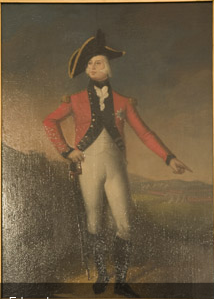
Prince Edward, Duke of Kent and Strathearn was ordered to live in at the headquarters of the Royal Navy's, North American Station in Halifax (1794–1800). He became the Commander-in-Chief, North America. He had a significant impact on the city. He was instrumental in shaping that port's military defences for protecting the important Royal Navy base, as well as influencing the city's and colony's socio-political and economic institutions. He also designed the Prince of Wales Tower, the Halifax Town Clock on Citadel Hill (Fort George), St Georges (Round) Church, Princes Lodge (only the round music room remains) and others. The Prince and his mistress, Madame de Saint-Laurent, lived at Prince's Lodge for the six years they stationed in Halifax.[39][40] (The Duke visited Kings County, Nova Scotia in 1794. As a result, in 1826, the inhabitants of the county voted to name their town Kentville after him). While in Halifax he was promoted to lieutenant-general in January 1796.[41]
Not until after suffering a fall from his horse in late 1798 was he allowed to return to England.[41] On April 24, 1799,[42] he was created Duke of Kent and Strathearn and Earl of Dublin, received the thanks of parliament and an income of £12,000 and was later, in May, promoted to the rank of general and appointed Commander-in-Chief of British forces in North America.[41] He took leave of his parents on July 22, 1799[43] and sailed to Halifax. Just over twelve months later he left Halifax[44] and arrived in England on August 31, 1800 where it was expected his next appointment would be Lord Lieutenant of Ireland.
19th century

By the early 19th century, Dartmouth consisted of about twenty-five families. Within twenty years, there were sixty houses, a church, gristmill, shipyards, sawmill, two inns and a bakery located near the harbour.
Napoleonic Wars
Halifax was now the bastion of British strength on the East Coast of North America. Local merchants also took advantage of the exclusion of American trade to the British colonies in the Caribbean, beginning a long trade relationship with the West Indies. However, the most significant growth began with the beginning of what would become known as the Napoleonic Wars. Military spending and the opportunities of wartime shipping and trading stimulated growth led by local merchants such as Charles Ramage Prescott and Enos Collins.
By 1796, Prince Edward, Duke of Kent, was sent to take command of Nova Scotia. Many of the city's forts were designed by him, and he left an indelible mark on the city in the form of many public buildings of Georgian architecture, and a dignified British feel to the city itself. It was during this time that Halifax truly became a city. Many landmarks and institutions were built during his tenure, from the Town Clock on Citadel Hill to St. George's Round Church, fortifications in the Halifax Defence Complex were built up, businesses established, and the population boomed. At the same time, the towns people and especially seafarers were constantly on-guard of the press gangs of the Royal Navy.
Halifax Impressment Riot

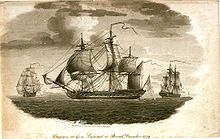

The Royal Navy's manning problems in Nova Scotia peaked in 1805. Warships were short-handed from high desertion rates, and naval captains were handicapped in filling those vacancies by provincial impressment regulations. Desperate for sailors, the Royal Navy pressed them all over the North Atlantic region in 1805, from Halifax and Charlottetown to Saint John and Quebec City. In early May, Vice Admiral Andrew Mitchell sent press gangs from several warships into downtown Halifax. They conscripted men first and asked questions later, rounding up dozens of potential recruits.[45]
The breaking point came in October 1805, when Vice Admiral Mitchell allowed press gangs from HMS Cleopatra to storm the streets of Halifax armed with bayonets, sparking a major riot in which one man was killed and several others were injured. Wentworth lashed out at the admiral for sparking urban unrest and breaking provincial impressment laws, and his government exploited this violent episode to put even tighter restrictions of recruiting in Nova Scotia.[46]
Stemming from impressment disturbances, civil-naval relations deteriorated in Nova Scotia from 1805 to the War of 1812. HMS Whiting was in Liverpool for only about a week, but it terrified the small town the entire time and naval impressment remained a serious threat to sailors along the South Shore. After leaving Liverpool, Whiting terrorized Shelburne by pressing inhabitants, breaking into homes, and forcing more than a dozen families to live in the forest to avoid further harassment.[47]
War of 1812
Though the Duke left in 1800, the city's prosperity continued to grow throughout the Napoleonic Wars and the War of 1812. While the Royal Navy squadron based in Halifax was small at the beginning of the Napoleonic Wars, it grew to a large size by the War of 1812 and ensured that Halifax was never attacked. The Naval Yard in Halifax expanded to become a major base for the Royal Navy and while its main task was supply and refit, it also built several smaller warships including the namesake HMS Halifax in 1806.[48]
Capture of U.S.S. Chesapeake



Several notable naval engagements occurred off the Halifax station. Most dramatic was the victory of the Halifax-based British frigate HMS Shannon which captured the American frigate USS Chesapeake and brought her to Halifax as prize. As the first major victory in the naval war for the British, the capture raised the shaken morale of the Royal Navy. Two-thirds of the men that followed British Captain Philip Broke in the boarding party were wounded or killed.[49] The casualties, 228 dead or wounded between the two ships' companies, were high, with the ratio making it one of the bloodiest single ship actions of the age of sail.[49] It had the single highest body count in an action between two ships in the entirety of the war.[50] By comparison, HMS Victory suffered fewer casualties during the much longer Battle of Trafalgar.
Shannon, commanded by Halifax's own Provo Wallis, escorted Chesapeake into Halifax, arriving there on June 6. On the entry of the two frigates into the harbour, the naval ships already at anchor manned their yards, bands played martial music and each ship Shannon passed greeted her with cheers.[51] The 320 American survivors of the battle were interned on Meville Island in 1813, and many later buried at nearby Deadman's Island. The American ship, renamed HMS Chesapeake, was used to ferry prisoners from Melville to England's Dartmoor Prison.[52] Many American officers were paroled to Halifax, but some began a riot at a performance of a patriotic song about Chesapeake's defeat.[53] Parole restrictions were tightened: beginning in 1814, paroled officers were required to attend a monthly muster on Melville Island, and those who violated their parole were confined to the prison.[54]
An invasion force sent from Halifax attacked Washington D.C. in 1813 in the Burning of Washington, setting the U.S. Capitol and White House ablaze. The leader of the force was Robert Ross, who died in the battle, was buried in Halifax.
Early in the war, an expedition left Halifax under the Lieutenant Governor of Nova Scotia, John Coape Sherbrooke, to captured Maine. They renamed the new colony New Ireland, which the British held for the entirety of the war. The revenues which were taken from this conquest were used after the war to finance a military library in Halifax and to found Dalhousie University which is today Atlantic Canada's largest university. There remains a street on campus called Castine Way, named after Castine, Maine. The city also thrived in the War of 1812 on the large numbers of captured American ships and cargoes captured by the British navy and provincial privateers. The wartime boom peaked in 1814. Present day government landmarks such as Government House, built to house the governor, and Province House, built to house the House of Assembly, were both built during the city's peak of prosperity at the end of the War of 1812.
Saint Mary's University was founded in 1802, originally as an elementary school. Saint Mary's was upgraded to a college following the establishment of Dalhousie University in 1819; both were initially located in the downtown central business district before relocating to the then-outskirts of the city in the south end near the Northwest Arm. Separated by only few minutes walking distance, the two schools now enjoy a friendly rivalry.
Black refugees


The next major migration of blacks into Nova Scotia occurred between 1813 and 1815. Black Refugees from the United States settled in many parts of Nova Scotia including Hammonds Plains, Beechville, Lucasville and Africville.
19th century prosperity
In the peace after 1815, the city at first suffered an economic malaise for a few years, aggravated by the move of the Royal Naval yard to Bermuda in 1818. However the economy recovered in the next decade led by a very successful local merchant class. Powerful local entrepreneurs included steamship pioneer Samuel Cunard and the banker Enos Collins. During the 19th century Halifax became the birthplace of two of Canada's largest banks; local financial institutions included the Halifax Banking Company, Union Bank of Halifax, People's Bank of Halifax, Bank of Nova Scotia, and the Merchants' Bank of Halifax, making the city one of the most important financial centres in colonial British North America and later Canada until the beginning of the 20th century. This position was somewhat rivalled by neighbouring Saint John, New Brunswick during the city's economic hey-day in the mid-19th century. Halifax was incorporated as the City of Halifax in 1842.
Throughout the nineteenth century, there were numerous businesses that were developed in HRM that became of national and international importance: The Starr Manufacturing Company, the Cunard Line, Alexander Keith's Brewery, Morse's Tea Company, among others. A modern water works system was built in 1844 to replace the city's original array of private and public wells. The Halifax Water Company, a private firm under contract to the City of Halifax built a gravity-fed main to deliver water to fire hydrants, public fountains and private customers in downtown Halifax from the Chain Lakes and Long Lake system near the city. It went into full operation in 1848 and was purchased by the City from the private company in 1861. [56]
Having played a key role to maintain and expand British power in North America and elsewhere during the 18th century, Halifax played less dramatic roles in the many decades of peace during the 19th Century. However, as one of the most important British overseas bases, the harbour's defences were successively refortified with the latest artillery defences throughout the century to provide a secure base for British Empire forces. Nova Scotians and Maritimers were recruited through Halifax for the Crimean War. The city boomed during the American Civil War, mostly by supplying the wartime economy of the North but also by offering refuge and supplies to Confederate blockade runners. The port also saw Canada's first overseas military deployment as a nation to aid the British Empire during the Second Boer War.
Halifax was founded below a drumlin that would later be named Citadel Hill. The outpost was named in honour of George Montague-Dunk, 2nd Earl of Halifax, who was the President of the Board of Trade. Halifax was ideal for a military base, with the vast Halifax Harbour, among the largest natural harbours in the world, which could be well protected with artillery battery at McNab's Island, the Northwest Arm, Point Pleasant, George's Island and York Redoubt. In its early years, Citadel Hill was used as a command and observation post, before changes in artillery that could range out into the harbour.
Royal Acadian School
In 1814, Walter Bromley opened the Royal Acadian School, which included many black children and adults. Bromley taught on the weekends because they were employed during the week.[57] Some of the black students entered into business in Halifax while others were hired as servants.[58]
New Horizons Baptist Church

New Horizons Baptist Church (formerly known as the African Chapel and the African Baptist Church) is a Baptist church in Halifax, Nova Scotia that was established by Black Refugees in 1832. When the chapel was completed, black citizens of Halifax were reported to be proud of this accomplishment because it was evidence that former slaves could establish their own institutions in Nova Scotia.[59] Under the direction of Richard Preston, the church laid the foundation for social action to address the plight of Black Nova Scotians.[60]
Preston and others went on to establish a network of socially active Black baptist churches throughout Nova Scotia, with the Halifax church being referred to as the "Mother Church."[59] Five of these churches were established in Halifax: Preston (1842), Beechville (1844), Hammonds Plains (1845), and another in Africville (1849) and Dartmouth.[61] From meetings held at the church, they also established the African Friendly Society, the African Abolition Society, and the African United Baptist Association.
The church remained the centre of social activism throughout the 20th Century. Reverends at the church included William A. White (1919-1936) and William Pearly Oliver (1937-1962).
City status
After a protracted struggle between residents and the Viceroys of Nova Scotia, the City of Halifax was incorporated in 1842.
Responsible government

Text je dostupný za podmienok Creative Commons Attribution/Share-Alike License 3.0 Unported; prípadne za ďalších podmienok. Podrobnejšie informácie nájdete na stránke Podmienky použitia.
Antropológia
Aplikované vedy
Bibliometria
Dejiny vedy
Encyklopédie
Filozofia vedy
Forenzné vedy
Humanitné vedy
Knižničná veda
Kryogenika
Kryptológia
Kulturológia
Literárna veda
Medzidisciplinárne oblasti
Metódy kvantitatívnej analýzy
Metavedy
Metodika
Text je dostupný za podmienok Creative
Commons Attribution/Share-Alike License 3.0 Unported; prípadne za ďalších
podmienok.
Podrobnejšie informácie nájdete na stránke Podmienky
použitia.
www.astronomia.sk | www.biologia.sk | www.botanika.sk | www.dejiny.sk | www.economy.sk | www.elektrotechnika.sk | www.estetika.sk | www.farmakologia.sk | www.filozofia.sk | Fyzika | www.futurologia.sk | www.genetika.sk | www.chemia.sk | www.lingvistika.sk | www.politologia.sk | www.psychologia.sk | www.sexuologia.sk | www.sociologia.sk | www.veda.sk I www.zoologia.sk

